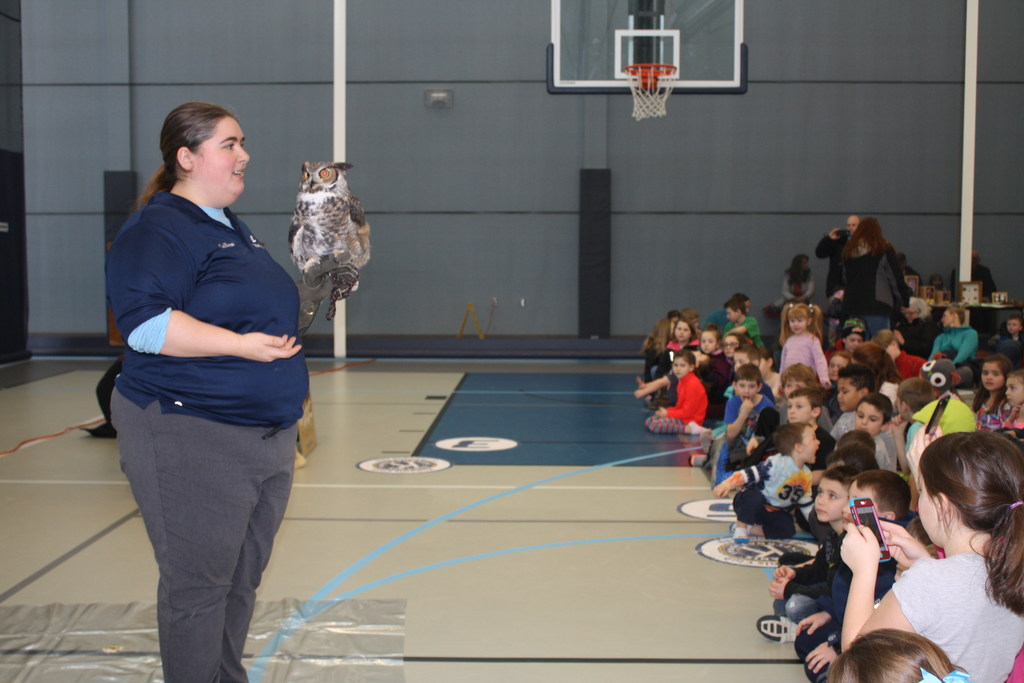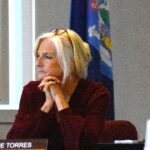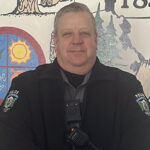
PRESQUE ISLE, Maine — Area children received a special visit from three native Maine owls and their human friend during a presentation from the Chewonki Traveling Natural History Program on Friday.
Colleen Moureaux, a science educator for the Wiscasset-based nonprofit Chewonki Foundation, brought Ozzie, a tiny Eastern Screech Owl; Beria, a Barred Owl; and Sparky, a large Great Horned Owl, to the Sargent Family Community Center on Feb. 22. But before those unique creatures made an appearance, Moureaux took the opportunity to teach her guests about what makes the species of Maine owls different from one another.
In general, Moureaux said, owls have large yellow eyes that they can move left to right and up and down so they can easily spot prey such as mice and rats while flying through the forests at night. They also have curved talons to capture and tear their prey and to grip tree branches. While flying, their feathers never make a sound so that prey don’t know they’re coming.
But Maine is home to several species of owls that live in the state yearound and have their own looks and sounds. The Great Horned Owl is the one that Moureaux calls the “Hollywood owl” because movies and TV shows most often use its call and it is the largest owl in Maine at 20 inches tall with a 48-inch wingspan.
The next owl that Moureaux told children about — the Saw Whet Owl — is much smaller.
“The Saw Whet Owl is only eight inches tall and that’s as tall as he’s going to get,” Moureaux said, pointing to a photograph of the creature. “He got his name because scientists believed his call sounded like an old-fashioned saw scraping against wood.”
Before revealing Ozzie, Beria and Sparky one at a time, Moureaux played samples of their owl calls, with each being different. The Barred Owl call especially got laughs from the audience, as it appears to be saying, “Who cooks for you? Who cooks for you, all?” The Eastern Screech Owl, which is more commonly found in southern areas of Maine, has a soft, high-pitched call that folks might mistake for a horse whinny.
Ozzie received an enthusiastic response from his young audience, with hundreds of children craning their necks to see the 10-inch tall owl. Then, as Moureaux showcased Beria the Barred Owl, she recalled that when the owl first came to Chewonki 12 years ago, staff members assumed she was a male because of her shorter size. Female owls tend to be larger because of the need to cover their eggs in the nest.
“A few years ago she went to a checkup at the vet. Our vet called us back later and said, ‘I got the results for your female Barred Owl,’” Moureaux said. “We said, ‘We don’t have a female Barred Owl,’ but it turns out we did the whole time.”
Sparky, a Great Horned Owl, was the final owl that Moureaux brought out to show the youngsters. She explained that Sparky came to Chewonki 25 years ago when he injured himself after accidentally flying into electric power lines. All animals who are part of Chewonki have been severely injured, preventing them from ever being able to survive in the wild again.
“Great Horned Owls are called the ‘tigers of the sky’ because they’re the largest owls,” Moureaux said. “They’ve even figured out how to hunt porcupines.”
After the presentation, Haley Himes, 10, of Mapleton, said that seeing owls like Sparky up close was one of her favorite parts.
“His eyes are so big,” she said. “I learned that owls’ eyes are like looking through binoculars because of how big they are.”
Haley’s brother Austin, 6, said that even though Ozzie was his favorite owl to see, he loved hearing the Barred Owl call.
“It’s a long sound and it was my favorite one,” he said.
From their Wiscasset location, Chewonki hosts elementary school aged and teen wildlife education programs, summer camps, leadership programs, an outdoor classroom and wilderness trips. Moureaux said that the Traveling Natural History Program also holds presentations on bugs, reptiles, tidepool creatures, mammals and ocean animals. Chewonki has visited Aroostook County for the past several years and also gave a presentation at the Nylander Museum in Caribou on Feb. 22.
“Where else can kids see three live owls up close?” Moureaux said, when describing what she loves about the owl presentation. “I hope they’ve learned about owls that might be in their own backyard and how to be nice to them if they see them in the wild.”







